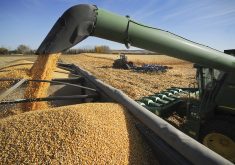In an era of tariffs, trade disruption and Brexit, simply maintaining a trade agreement has become a big deal.
On Dec. 10, Nancy Pelosi, speaker of the U.S. House of Representatives, announced her support for the United States-Mexico-Canada Agreement (USMCA). That means the U.S. government will approve the trade deal, possibly early in 2020, and Canadian farmers don’t have to worry about the American or Mexican markets.
“The real driver was making sure … we didn’t (get) new tariffs. We didn’t (get) new tariffs with Mexico, we didn’t (get) new tariffs with the U.S.,” said Claire Citeau, executive director of the Canadian Agri-Food Trade Alliance.
Read Also

Canadian Food Inspection Agency extends chronic wasting disease control program consultation deadline
Date extended for consultation period of changes to CWD program
“What it means for Canadian agri-food exporters is a certain future. I underline ‘certain.’ ”
The deal was reached in principle in September 2018, replacing the North American Free Trade Agreement.
However, the Democrats wanted changes to protect U.S. workers and the environment. Once Mexico accepted those provisions, the House was willing to support the deal.
During the last few years, large countries and regions have been using tariffs and non-tariff trade barriers more frequently as economic and political weapons.
So, having trade certainty in North America is a win for farmers in a mid-sized country like Canada. For beef producers, having access to global markets means on average that each animal is worth about $600 more, compared to domestic sales alone, the Canadian Cattlemen’s Association said in a release.
“CUSMA (USMCA) will allow beef producers across all three of our countries to continue to grow and prosper,” said David Haywood-Farmer, CCA president.
U.S. farm groups also used the word “certainty” to describe the benefits of USMCA.
“It’s been a brutal year for many farmers who really need the certainty this would provide for agricultural trade,” said National Corn Growers Association president Kevin Ross.
Besides stability, the USMCA offers potential benefits for Canadian food exporters. One opportunity could be margarine.
Under NAFTA, there was about a seven percent tariff on Canadian margarine exported to the U.S. That’s because margarine has palm oil, although usually in small amounts in Canadian-made product, and palm oil isn’t produced in North America. The new deal removes that tariff, so Canadian oilseed processors could produce more margarine on this side of the border.
“Currently the U.S. market is around $800 million … just for margarine,” said Brian Innes, Canola Council of Canada vice-president of public affairs, in 2018.
“We export about $8 million (to the U.S.).”
Governments of the three countries still need to ratify the deal. That’s expected to happen before the end of 2019 or early in 2020.
As of press time Dec. 16, the Mexican government objected to language in the USMCA version submitted to the U.S. Congress. It is unhappy with a clause saying U.S. attachés, or inspectors, would be posted in Mexico to monitor labour reforms at Mexican businesses.
robert.arnason@producer.com















